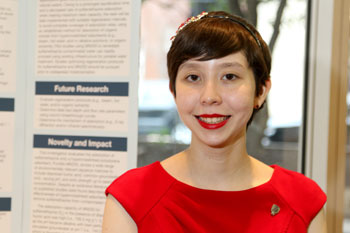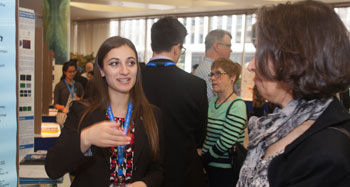When teens fall in love — with science
Finalists of the Intel Science Talent Search share why they do research

The 40 finalists of the Intel Science Talent Search came to Washington, D.C., this week.
L. Doane/SSP
WASHINGTON, D.C. — In novels, there is often a moment where a character suddenly realizes that she loves someone. The teens you can hear from below all had that moment — but for them, their love was science.

But many of these teens don’t do research for any recognition they might receive. They simply enjoy using science, technology, engineering and math (STEM) to solve problems they see in the world. Here, in their own words, six teens describe the time they knew they were falling for science.
I fell in love with science when I first asked, ‘Why is the sky blue?’ I realized I could ask questions about the world, and science would let me discover.
– Helen Liu 18, Amity Regional High School, Woodbridge, Conn.
The first time I got real results and I could say that…I found something new that no one else had ever seen before, and it was something worth studying.
– Kunal Schroff, 17, Thomas Jefferson High School for Science and Technology, Alexandria, Va.

I first fell in love with science when I discovered something I totally wasn’t expecting. I was able to remove a common veterinary drug — called sulfamethazine — from water…. It was really amazing being able to discover this and contribute to the scientific community.
– Maria Elena Grimmett, 17, Oxbridge Academy of the Palm Beaches, West Palm Beach, Fla.
One moment where I fell in love with science was in seventh grade, when I finished my first science project on the effect of [ultraviolet] light and infrared light on plant growth. Really seeing my first set of results and making my own conclusions for the first time was a magical moment for me.
– Milind Jagota, 18, Liberty High School, Bethlehem, Pa.

When I first went to the beach and I saw some jellyfish, just lying in the sand. I fell in love with animal sciences and just how cool these creatures were that live in the oceans around us.
– Rachel Mashal, 18, John F. Kennedy High School, Bellmore, N.Y.
I fell in love with math in sixth grade. Before that I used to be really interested in physical puzzles. Afterwards, I started doing math problems. I really found it interesting, trying to [take] the little pieces of the [math] puzzle and put it together in an unconventional way.
– Vikul Gupta, 17, Oregon Episcopal School, Portland, Ore.
Follow Eureka! Lab on Twitter
Power Words
(for more about Power Words, click here)
infrared light A type of electromagnetic radiation invisible to the human eye. The name incorporates a Latin term and means “below red.” Infrared light has wavelengths longer than those visible to humans. Other invisible wavelengths include X rays, radio waves and microwaves. It tends to record a heat signature of an object or environment.
Intel Science Talent Search An annual competition created and run by Society for Science & the Public and sponsored by Intel Corp. Begun in 1950, this event brings 40 research-oriented high school seniors to Washington, D.C. to showcase their research to the public and to compete for awards.
jellies (in biology) These are gelatinous animals that drift in water (mostly seawater) or brackish (semi-salty) estuaries. For more than 500 million years, they have moved around the oceans by pumping pulses of water through their jelly-like tissue. Their body often has an umbrella-shaped bell. Trailing from around a central mouth may be many tentacles. Although jellies don’t have brains, they do have a nervous system which can sometimes detect light, movement or certain chemicals. Some members of this family, known as cnidarians, are known as jellyfish. In fact, none are true fish but related to hydras and corals.
Society for Science and the Public (or SSP) A nonprofit organization created in 1921 and based in Washington, D.C. Since its founding, SSP has been not only promoting public engagement in scientific research but also the public understanding of science. It created and continues to run three renowned science competitions: The Intel Science Talent Search (begun in 1942), the Intel International Science and Engineering Fair (initially launched in 1950) and Broadcom MASTERS (created in 2010). SSP also publishes award-winning journalism: in Science News (launched in 1922) and Science News for Students (created in 2003). Those magazines also host a series of blogs (including Eureka! Lab).
STEM An acronym (abbreviation made using the first letters of a term) for science, technology, engineering and math.
sulfamethazine A type of antibiotic, which is a chemical that can kill bacteria.
ultraviolet A portion of the light spectrum that is close to violet but invisible to the human eye.